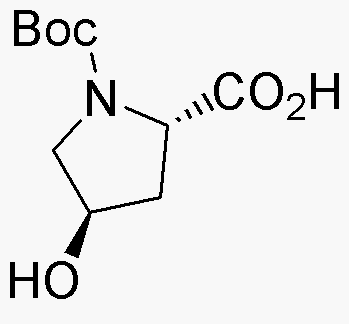Boc-L-trans-4-hydroxyproline is widely utilized in research focused on:
- Peptide Synthesis: This compound serves as a key building block in the synthesis of peptides, particularly in the development of bioactive peptides that can be used in pharmaceuticals.
- Drug Development: Its unique structure allows for the modification of drug candidates, enhancing their stability and bioavailability, which is crucial in medicinal chemistry.
- Biomaterials: The compound is used in creating hydrogels and other biomaterials, which are essential in tissue engineering and regenerative medicine.
- Research on Collagen: It plays a significant role in studying collagen stability and structure, providing insights into skin health and wound healing.
- Cosmetic Formulations: Its properties make it beneficial in cosmetic products aimed at improving skin texture and hydration, appealing to the beauty and personal care industry.
General Information
Properties
Safety and Regulations
Applications
Boc-L-trans-4-hydroxyproline is widely utilized in research focused on:
- Peptide Synthesis: This compound serves as a key building block in the synthesis of peptides, particularly in the development of bioactive peptides that can be used in pharmaceuticals.
- Drug Development: Its unique structure allows for the modification of drug candidates, enhancing their stability and bioavailability, which is crucial in medicinal chemistry.
- Biomaterials: The compound is used in creating hydrogels and other biomaterials, which are essential in tissue engineering and regenerative medicine.
- Research on Collagen: It plays a significant role in studying collagen stability and structure, providing insights into skin health and wound healing.
- Cosmetic Formulations: Its properties make it beneficial in cosmetic products aimed at improving skin texture and hydration, appealing to the beauty and personal care industry.
Documents
Safety Data Sheets (SDS)
The SDS provides comprehensive safety information on handling, storage, and disposal of the product.
Product Specification (PS)
The PS provides a comprehensive breakdown of the product’s properties, including chemical composition, physical state, purity, and storage requirements. It also details acceptable quality ranges and the product's intended applications.
Certificates of Analysis (COA)
Search for Certificates of Analysis (COA) by entering the products Lot Number. Lot and Batch Numbers can be found on a product’s label following the words ‘Lot’ or ‘Batch’.
*Catalog Number
*Lot Number
Certificates Of Origin (COO)
This COO confirms the country where the product was manufactured, and also details the materials and components used in it and whether it is derived from natural, synthetic, or other specific sources. This certificate may be required for customs, trade, and regulatory compliance.
*Catalog Number
*Lot Number
Safety Data Sheets (SDS)
The SDS provides comprehensive safety information on handling, storage, and disposal of the product.
DownloadProduct Specification (PS)
The PS provides a comprehensive breakdown of the product’s properties, including chemical composition, physical state, purity, and storage requirements. It also details acceptable quality ranges and the product's intended applications.
DownloadCertificates of Analysis (COA)
Search for Certificates of Analysis (COA) by entering the products Lot Number. Lot and Batch Numbers can be found on a product’s label following the words ‘Lot’ or ‘Batch’.
*Catalog Number
*Lot Number
Certificates Of Origin (COO)
This COO confirms the country where the product was manufactured, and also details the materials and components used in it and whether it is derived from natural, synthetic, or other specific sources. This certificate may be required for customs, trade, and regulatory compliance.


